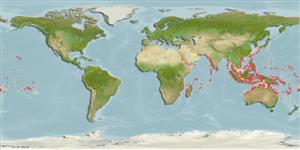Common names from other countries
Environment: milieu / climate zone / depth range / distribution range
Ecologie
; diepteverspreiding 0 - 30 m (Ref. 349). Tropical; 35°N - 34°S, 30°E - 138°W
Indo-Pacific.
Length at first maturity / Size / Gewicht / Leeftijd
Maturity: Lm ? range ? - ? cm Max length : 16.0 cm SHL mannelijk/geslacht niet bekend; (Ref. 349); common length : 9.0 cm SHL mannelijk/geslacht niet bekend; (Ref. 349)
Commonly collected for food in many parts of the area, mainly in the shallow water zone. Shell used for shellcraft. Due to frequent over collecting and destruction of the coral reef environment by dynamite fishers, this species may be nearly extinct locally or confined to the deeper part of its habitat (to depths over 10 m) (Ref. 349). Known to be abundant in reef areas, on sand, among rocks (Ref. 128042), on branched corals, often nearby seaweeds. Active during the day (Ref. 349). Omnivore (Ref. 112158). In general, cowries are observed to feed on sponges, live gastropods, seaweed, and carrion (Ref. 112163).
Life cycle and mating behavior
Geslachtsrijpheid | Voortplanting | Kuitschieten | Eieren | Fecundity | Larven
Members of the order Neotaenioglossa are mostly gonochoric and broadcast spawners. Life cycle: Embryos develop into planktonic trocophore larvae and later into juvenile veligers before becoming fully grown adults.
Poutiers, J.M. 1998. (Ref. 349)
Status op de Rode Lijst van het IUCN (Ref. 130435)
Status bij CITES (Ref. 108899)
Not Evaluated
Not Evaluated
Gevaarlijk voor mensen
Harmless
Gebruik door de mens
Visserij: commercieel
| FishSource | Sea Around Us
Tools
Meer informatie
Leeftijd/GrootteGroeiLengte-gewicht parametersLengte-lengte parametersMorfologieLarvenAbundantie
Internet-bronnen
Estimates based on models
Preferred temperature
(Ref.
115969): 25.4 - 29.3, mean 28.7 (based on 2229 cells).
Kwetsbaarheid
Low vulnerability (10 of 100).
Prijsklasse
Unknown.
